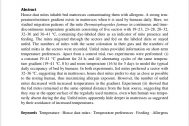Obsah
House dust mites inhabit bed mattresses contaminating them with allergens. A strong temperature/moisture gradient exists in mattresses when it is used by humans daily. Here, we studied migration patterns of the mite Dermatophagoides farinae in continuous and time-discontinuous temperature gradients consisting of five sectors with 19–23, 23–28, 28–32, 32–36 and 36–41 °C, containing dye-labeled diets as an indicator of mite presence and feeding. The mites migrated through the sectors and fed on the labeled diets or stayed unfed. The numbers of mites with the same coloration in their guts and the numbers of unfed mites in the sectors were recorded. Unfed mites provided information on short-term temperature preferences. Apart from a control trial, two experiments were performed: (i) a constant 19–41 °C gradient for 24 h, and (ii) alternating cycles of the same temperature gradient (19–41 °C, 8 h) and room temperature (16 h) for 5 days to model the typical daily occupancy of bed by humans. In both experiments, fed mites preferred a sector with 32–36 °C, suggesting that in mattresses, house dust mites prefer to stay as close as possible to the resting human, thus maximizing allergen exposure. However, the number of unfed mites decreased with increased temperatures in the gradient. Experiment (ii) showed that the fed mites remained at the same optimal distance from the heat source, suggesting that they stay at the upper surface of the regularly used mattress, even when human was temporarily absent during the day. Unfed mites apparently hide deeper in mattresses as suggested by their avoidance of increased temperatures.



